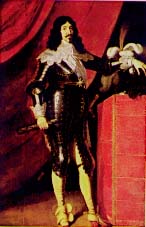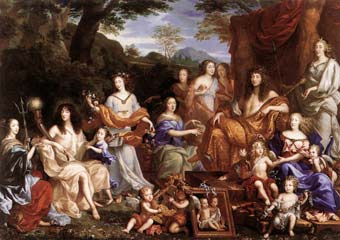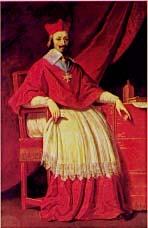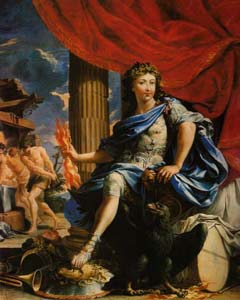History Online - Louis XIV
[an error occurred while processing this directive]Louis XIV
The Sun King
 Louis XIV's parents, King Louis XIII and his wife Anne of Austria, hated each other. Their marriage remained unconsummated for at least four years; it was 23 years before their first child, Louis, was born in 1638. Apparently encouraged by this success, the royal couple produced another son, Philippe, in 1640.
Louis XIV's parents, King Louis XIII and his wife Anne of Austria, hated each other. Their marriage remained unconsummated for at least four years; it was 23 years before their first child, Louis, was born in 1638. Apparently encouraged by this success, the royal couple produced another son, Philippe, in 1640.
When young Louis was four, his father fell gravely ill with tuberculosis. Knowing that he was about to die, the king ordered that his eldest son be baptised (which normally would have taken place when the prince was seven). At the ceremony the boy was given the name Louis Dieudonne, or "Gift of God," because his birth had seemed so miraculous. Afterward he was brought to his father's deathbed. "What is your name?" Louis XIII asked.
"Louis XIV," the little boy replied.
"Not yet, not yet," said the king. But less than a month later he died, and his four-year-old son did indeed become King Louis XIV of France.
 For 18 years, Anne of Austria (who despite her name had been born a Spanish princess) served as her son's regent, advised by Cardinal Mazarin. The cardinal may have been the queen's lover or even her secret husband. Whatever the truth of that, Mazarin's relationship with Louis was like that of father and son.
For 18 years, Anne of Austria (who despite her name had been born a Spanish princess) served as her son's regent, advised by Cardinal Mazarin. The cardinal may have been the queen's lover or even her secret husband. Whatever the truth of that, Mazarin's relationship with Louis was like that of father and son.
Family life was less sunny for Louis's only sibling, Philippe, who was called Monsieur at court and eventually became Duke of Orleans. Treated with suspicion by his mother and the cardinal, constantly shunted aside and poorly educated to keep him from outshining his elder brother, Philippe grew up to be a frivolous man, more interested in fashion and society than politics and government. He was also openly homosexual, which made him an object of scorn, even to his womanizing brother.
But there was more to Philippe than met the eye. He was an able military leader, a keen collector of art, and perhaps a shrewd investor (as Nancy Nichols Barker suggests in her book Brother to the Sun King). Given a chance, he might have made a fine king -- which was just why his mother went to such lengths to keep him in his place.
When King Louis was in his teens he fell in love with Marie Mancini, a niece of Cardinal Mazarin. The two secretly became engaged, but Louis's mother refused to allow the match. Marie Mancini was packed off to Italy to marry a nobleman, and Louis reluctantly agreed to a political marriage with Maria Theresa, the daughter of the king of Spain. The couple would have seven children, but only one -- a son named Louis -- survived to adulthood.
 Cardinal Mazarin died in 1661, when Louis XIV was 22 years old. From that time on, Louis XIV was the sole ruler of France. He reigned for 72 years, longer than any other ruler in European history. Under his leadership France became a world power and a leader in the arts. He was an absolute monarch, as expressed in the famous quote attributed to him, "L'etat c'est moi" (I am the state). Identifying himself with Apollo, the Greek god of the sun, Louis XIV came to be called "the Sun King."
Cardinal Mazarin died in 1661, when Louis XIV was 22 years old. From that time on, Louis XIV was the sole ruler of France. He reigned for 72 years, longer than any other ruler in European history. Under his leadership France became a world power and a leader in the arts. He was an absolute monarch, as expressed in the famous quote attributed to him, "L'etat c'est moi" (I am the state). Identifying himself with Apollo, the Greek god of the sun, Louis XIV came to be called "the Sun King."
Today Louis XIV is perhaps best remembered as the king who built Versailles. When he became king he inherited several palaces, including the Fontainebleau and the Louvre. But after visiting the beautiful home of his minister, Nicholas Fouquet, he decided to build something even more magnificent.
He moved his court to the little village of Versailles, where he owned a quaint hunting lodge. First he improved the grounds with lavish gardens, sculptures, terraces, a lake, a zoo, and 1,500 fountains. In 1668 work started on the main chateau. The old buildings were surrounded by grand new ones designed by Louis Le Vaux and Francois Dorbay. Francois Mansard created the opulent Hall of Mirrors.
Smaller palaces were added nearby, including Marly-le-Roi, the Grand Trianon, and the Petit Trianon. The entire project cost 66 million livres.
After Louis's death, Versailles was used as a royal residence by his great-grandson Louis XV. The Sun King's great-great-great-grandson Louis XVI also lived there, along with his wife Marie Antoinette. Badly damaged in the French Revolution, the palace was restored by subsequent rulers and eventually became a museum, which it remains to this day.
Louis XIV was much occupied with religion and religious questions. His reign is generally considered as divided into two periods: (1) that of libertinage, during which his heart was ruled by Mlle de la Vallière, Madame de Montespan, and other favourites; (2) that of devotion, coinciding with the influence of Madame de Maintenon, the widow of Scarron, who, when Marie Theresa died (31 July, 1683), secretly married the king, and who, for a quarter of a century, assisted him in ruling the kingdom. The second of these two periods was also that of the influence of Père Le Tellier (q.v.). This division is natural and accounts for certain developments of religious policy; but it must not be exaggerated. Even during his period of libertinage, Louis XIV took a passionate interest in religious questions; and during his devout period, he never altogether abandoned those Gallican principles which incessantly exposed him to conflicts with Rome. Certain pamphlets, published in the days of the Fronde, opposed to the doctrines of royal absolutism the old theological doctrine of the origin and the responsibilities of power. Le Théologien Politique declares that obedience is due only to those kings who demand what is just and reasonable; the treatise Chrétien et Politique asserts that kings do not make peoples, but that peoples have made kings. But the doctrine of the Divine right of kings succeeded in establishing itself upon the ruins of the Fronde; according to that doctrine Louis XIV had to reckon only with God, and the same doctrine served as one of the supports of the dictatorship which he pretended to exercise over the Church of France.
In the Mémoires of Louis XIV a whole theory of the relations between Church and State is expounded. He sets forth that the king is the proprietor of the Church's wealth, in virtue of the maxim that there is no other proprietor in the kingdom but the king. He holds that all the faithful, "whether lay or tonsured," are the sovereign's subjects; that the clergy are bound to bear their part pecuniarily in the public burdens, and that they "should not excuse themselves from that obligation by alleging that their possessions are for a particular purpose, or that the employment of those possessions must be regulated by the intention of the donors." The assemblies of the clergy, which discuss the amounts to be contributed by the clergy, are, in the eyes of Louis XIV, only tolerated; he considers that, as sovereign, he would be within his rights in laying imposts upon the clergy, and that "the popes who have wished to contest that right of royalty have made it clearer and more incontestable by the distinct withdrawal of their ambitious pretensions which they have been obliged to make;" he declares it to be inadmissible that ecclesiastics, "exempt from the dangers of war and the burden of families," should not contribute to the necessities of the State. The Minims of Provence had dedicated to Louis XIV a thesis in which they compared him to God; Bossuet declared that the king could not tolerate any such doctrine, and the Sorbonne condemned it. But at Court the person of the king was the object of a sort of religious worship, in which certain courtier bishops too easily acquiesced, and the consequence of which became perceptible in the relations between the Church and the State.
From these principles resulted his attitude towards the assemblies of the clergy. He shortened the duration of their sessions and caused them to be watched by his ministers, while Colbert, who detested the financial autonomy enjoyed by the clergy, went so far as to say that it would be well "to put a stop to these assemblies which the wisest politicians have always considered diseases of the body politic." From these principles, too, arose the fear of everything by which churchmen could acquire political influence. Unlike his predecessors, Louis XIV employed few prelates in the service of the State.
The Concordat of Francis I placed a large number of benefices at the disposal of Louis XIV; he felt that the appointment of bishops was the most critical part of his kingly duty, and the bishops whom he appointed were, in general, very well chosen. He erred, however, in the readiness with which he dispensed them from residence in their dioceses, while, as to abbacies, he too often availed himself of them to reward services rendered by laymen, and gave them as means of support to impoverished nobles. To the Comte du Vexin, his son by Madame de Montespan, he gave the two great Abbacies of Saint-Denis and Saint-Germain-des-Prés.
Louis XIV was particularly fond of taking a hand in doctrinal matters; and those who surrounded him ended by believing that the king could supervise the Church and supply it with information on religious questions. Daguesseau, on 14 August, 1699, went so far as to proclaim that the King of France ought to be both king and priest. Thus it was that, for example, in the midst of the war of the League of Augsburg, Louis was careful to have a report prepared for him on a catechism which was suspected of Jansenism; and so, again, in 1715, he caused a lieutenant of police to be reprimanded for neglecting to report three preachers of Paris who were in the habit of speaking of grace in a Jansenistic manner.
 Many people found it difficult to believe that Louis XIV was really the son of Louis XIII and his wife, Anne of Austria for one simple reason: Louis XIII and his wife hated each other. Their marriage remained unconsummated for at least four years; it was twenty-three years before their first child, Louis, was born.
Many people found it difficult to believe that Louis XIV was really the son of Louis XIII and his wife, Anne of Austria for one simple reason: Louis XIII and his wife hated each other. Their marriage remained unconsummated for at least four years; it was twenty-three years before their first child, Louis, was born.
Rumors flew that Louis, the "God given" miracle child, was actually the son of Anne's favorite, the Duc de Beaufort. Legend has it that Beaufort was imprisoned in the iron mask to prevent anyone from learning that he was the king's real father.
 Beaufort was not the only man rumored to have conducted an affair with Anne. Years earlier she had enjoyed a brief flirtation with the English Duke of Buckingham. It has been suggested that the Iron Mask was their secret son. Another story links Anne to a foreigner known only as C.D.R. Like Beaufort, C.D.R. is said to have been Louis's real father, and like Beaufort he supposedly ended up in the iron mask. In yet another version of the story, the Iron Mask is Marc de Jarrigue de La Morelhie, the son-in-law of the queen's physician. Morelhie stumbles across proof that Louis XIV is not Louis XIII's son, and is imprisoned in the iron mask to prevent him from sharing his dangerous knowledge with others.
Beaufort was not the only man rumored to have conducted an affair with Anne. Years earlier she had enjoyed a brief flirtation with the English Duke of Buckingham. It has been suggested that the Iron Mask was their secret son. Another story links Anne to a foreigner known only as C.D.R. Like Beaufort, C.D.R. is said to have been Louis's real father, and like Beaufort he supposedly ended up in the iron mask. In yet another version of the story, the Iron Mask is Marc de Jarrigue de La Morelhie, the son-in-law of the queen's physician. Morelhie stumbles across proof that Louis XIV is not Louis XIII's son, and is imprisoned in the iron mask to prevent him from sharing his dangerous knowledge with others.
It has even been claimed that the Iron Mask was the daughter of Anne of Austria and Louis XIII. Fearing their first child would be their last, and needing a boy child to inherit the throne, the royal couple supposedly swapped their baby girl for someone else's son. The imposter was raised as Louis XIV, and the real princess was banished to imprisonment in the iron mask. (This story was politically motivated. A year after Louis XIV's birth, Anne of Austria gave birth to her second son, Philippe. The enemies of Louis XIV's descendants wanted to believe that Philippe, not Louis, was Louis XIII's eldest son and the rightful heir to the throne.)
Louis XIV's father died when he was four. For 18 years Anne of Austria served as her son's regent, advised by Cardinal Mazarin. It was whispered that she had married Mazarin. Eventually the story arose that Anne and Mazarin had a secret son who became -- of course! -- the Man in the Iron Mask.
Louis XIV is 23 years old in the Alexandre Dumas story The Man in the Iron Mask. The story's characters include Louis's mother, Anne of Austria, and his mistress, Louise de Valliere. Louis's ministers Colbert and Fouquet also play important roles. The king did have a group of aristocratic guards called the Musketeers, but the musketeers in Dumas's story are fictional.
One of the reasons Louis XIV is so well remembered today is that he built the spectacular French palace of Versailles. The Leonardo DiCaprio movie The Man in the Iron Mask (based on Dumas's novel) takes place in the 1660s, when Louis XIV was just beginning to improve his property at Versailles. Parts of the movie were shot at Nicholas Fouquet's lovely palace, Vaux-le-Vicomte, which inspired Louis XIV to build Versailles. The king's envy of Vaux led him to have Fouquet arrested -- and some people believe that it was Fouquet who became the Man in the Iron Mask.

